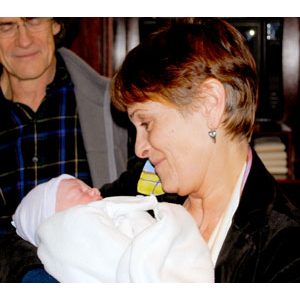
In a previous entry, Dr. Ransom shared how she uses music to have beautiful days with her grandson. Now she’s back with some ideas for how you might decipher and support the musical sounds that your baby makes every day.
What is vocal development for an infant? What does vocal development look like? We all know the sound babies make—they cry. But actually, there’s a lot to notice about how your baby cries. Parents and caregivers can tell if the child wants attention, wants food, is hurt, is “play-acting,” or is bored.
If you’d enjoy some at-home research, you might try noticing if your baby cries around a certain pitch or cries higher or lower at particular times. You might even go try to match the pitch (note) of his or her cry to an instrument—a keyboard, xylophone, or guitar—just to give the crying pitch a name.
You can also notice whether the other types of crying and squealing are similar to or different from the hunger cry. My grandson Jackson shocks me with his high-pitched squeals—way up in high soprano land—but his basic cry is the E above middle C.
Beyond the dramatic sounds of almost crying and really crying, there is a huge repertoire to observe.
- Crying when hungry
- Sound-making for pleasure: random and experimental at first, just like learning to grasp *Sustained vowel sounds [aaah, eeee, or ooooo]
- Punctuations or staccato notes: short, accented sounds, not a sustained cry [ah!]
- Sustained dipthong: multiple vowels shifting from one to another [aaaauuuu—eeee!]
- Squeals and swoops, most often from high pitch to low
- Spit gurgles, usually when the baby is on his/her back
- Consonant-vowel combinations, a favorite personal “vocable”
Pitched sounds:
- Coos: long note on one or two sounds
- Giggles and giggle-singing: a huge gamut of high to low notes
- Resting tone after or during a song sung by caregivers (watch for this at 2 months)
- Pitches related to the resting tone: 5th note above it, 3rd note above it (2–3 months)
- Nonstop babble, with occasional sustained singing (often 8 months or later)
Your baby may make some of these sounds and others unique to him or her as well. Jackson has a unique sound when he starts to get hungry. He whines on a pitch and if I whine with him, he’s surprised and distracted and he likes the duet. I can buy myself a minute or two to get his bottle ready! If I don’t hurry, though, it turns into full-fledged crying, very loud—on that “E” pitch!
The order in which your baby experiments with these things is not important. That your baby PLAYS and experiments vocally is important. How can you help? Babble, coo, and giggle-sing with your baby. Try it and, before long, you might find you’re having as much fun as your infant.
The other way you can help is by providing a lot of music data for reception. You are the ones who can create an environment full of interesting sounds: singing, chanting, learning guitar, dancing to old favorites. You are the ones who provide the raw material for your child to hear, remember, categorize, and create with. You are the ones who let the child know that dancing, singing, reading, swimming, cooking, science, and nature are good and fun. Respond to your baby for any sound he makes—greet him with a similar sound, smile, look at his eyes, do something that you know your baby likes. (Jackson likes the bottoms of his feet rubbed.)
In Music Together class, you may have heard your teacher talk about reception and expression—two terms from the psychology of learning which can help us understand what’s involved as your child becomes a confident, competent music maker. Reception means receiving information and organizing it, integrating it with other information your child already knows. If you sing a familiar song like “Tingalayo” to her in a slightly different way, she’ll receive that information and add it to what she already knows about “Tingalayo.” Watch her eyes, legs, arms, eyebrows, etc., for her response to the song. At some point she may express to you her version of “Tingalayo,” which will let you peek into her musical memory as well as her sense of musical play.
I ran across a term in an old book, the New York Times Everyday Reader’s Dictionary of Misunderstood, Misused, Mispronounced Words. The term was ear-minded: being more aware or responsive to sound than sight, smell, etc. How perfect for babies! I hope you enjoy singing and moving with your ear-minded infant as he or she develops other life skills. What joy to have made it through your own childhood, then experience it anew through the eyes of your baby.



